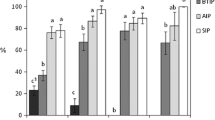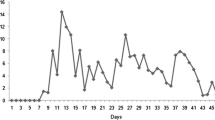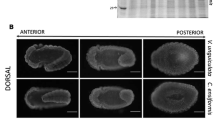Abstract
Studies on effect of seed species and their interacting influence on food utilization ofCallosobruchus maculatus clearly pointed out that rates and efficiencies of nitrogen utilization are determined by the composition of the seed also. Of the 3 species of seeds tested,Vigna unguiculata has significantly more nitrogen and water per unit weight than the other two seeds,Dolichos lab lab andPhaseolus radiatus. With increasing nitrogen content of the seed, rates of feeding, assimilation and metabolism decreased. On the other hand efficiencies of assimilation and net production increased. Nitrogen assimilation efficiency ofCallosobruchus maculatus ranged from 76·6% inDolichos lab lab to 85·8% inVigna unguiculata. The efficiency of accumulation of assimilated nitrogen was around 82%. The less nutritiousDolichos lab lab contributed more to the observed variance in the efficiencies of assimilation and production. The low efficiencies may be attributed to the presence of protease inhibitors.
Similar content being viewed by others
References
Applebaum S W and Guez M 1972 Comparative resistance ofPhaseolus vulgaris beans toC. chinensis andAcanthoscelides obtectus;Entomol. Exp. Appl. 15 203–207
Bernays B A and Simpson S J 1982 Control of food intake;Adv. Insect Physiol. 16 59–118
Cairns S C 1982 Growth energetics in relation to temperature of the larvae ofRhopaea verreauxi;Oecologia (Berlin) 54 32–40
Gilbert L I 1964 Physiology of growth and development; Endocrine aspects;Physiol. Insects 1 150–214
Janzen D H, Juster H B and Linear I E 1976 Insecticidal action of the phytohaemagglutinin in black beans on a Bruchid beetle;Science 192 795–796
Krishnan M 1985Studies on the bioenergetics of a chosen pest Pericallia ricini (Fab.), Ph. D thesis, Madurai Kamaraj University, Madurai
Lowry O H, Rosebrough N J, Farr A L and Randal R J 1951 Protein measurement with the folin phenol reagent;J. Biol. Chem. 193 265–275
Lawton J H 1971 Ecological energetics studies on larvae of the damsel flyPyrrhosoma nymphula;J. Anim. Ecol. 40 385–424
Mattson W J Jr 1980 Herbivory in relation to plant nitrogen content;Annu. Rev. Ecol. Syst. 11 119–161
McNeill S and Southwood T R E 1978 The role of nitrogen in the development of insect-plant relationships; inBiochemical aspects of plant and animal coevolution (London: Academic Press) pp 77–79
Muthukrishnan J, Mathavan S and Venkatasubbu K 1979 Effects of caffeine and theophylline on food utilization and emergence inDanaus chrysippus L;Entomon 4 307–312
Muthukrishnan J and Pandian T J 1984 Effects of interaction of ration and temperature on growth and bioenergetics ofAchaea janata;Oecologia (Berlin) 62 272–275
Pandian T J 1973 Food intake and energy expenditure pattern in two insect primary consumers;Curr. Sci. 42 423–425
Pandian T J and Marian M P 1985 Nitrogen content of food as an index of absorption efficiency in fishes;Mar. Biol. 85 301–311
Petrusewicz K and Macfadyen A 1970Productivity of terrestrial animals IBd Hand Book No. 13 (Oxford: Blackwell)
Pingale S V 1976Handling and storage of food grains (Madras: Diocesan Press)
Scriber J M and Feeny P P 1979 The growth of herbivorous caterpillars in relation to degree of feeding specialization and to growth form of food plant;Ecology 60 829–850
Scriber J M and Slansky F Jr 1981 The nutritional ecology of immature insects;Annu. Rev. Entomol. 26 182–211
Seifter S and Dayton S 1950 The estimation of glycogen with anthrone reagent;Arch. Biochem. Biophys. 25 191–200
Singh R N and Krishna S S 1980 Studies on some specific biological and temporal factors affecting mating and/or oviposition inTribolium castaneum;Bolm. Zool. Univ. S. Pauls 5 19–29
Umbreit W W, Burris R H and Stauffer J F 1974 Method of nitrogen estimation; inMonometric and biochemical techniques (Minnesota: Burgess Publishing Co.,) pp 259–260
Waldbauer G P 1968 The consumption and utilization of food by insects;Adv. Insect Physiol. 5 229–288
White N D G and Sinha R N 1981 Energy budget forOryzaephilus surinamensis feeding on rolled oats;Environ. Entomol. 10 320–326
Wigglesworth V B 1972The principles of insect physiology (London: Chapman and Hall)
Zar J E 1974Biostatistical analysis (New Jercey: Prentice Hall)
Author information
Authors and Affiliations
Rights and permissions
About this article
Cite this article
Chandrakantha, J., Mathavan, S. & Muthukrishnan, J. Nitrogen budget ofCallosobruchus maculatus larva developing in different host seed species. Proc. Indian Acad. Sci. (Anim. Sci.) 98, 359–365 (1989). https://doi.org/10.1007/BF03179962
Received:
Revised:
Issue Date:
DOI: https://doi.org/10.1007/BF03179962




